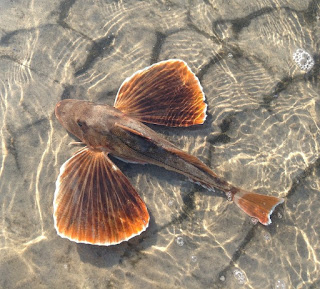Today’s fishing began with an unfortunate encounter with a ridiculously unfriendly and sullen lure fisherman, but I would like to leave it out here. Then I started sharing the tip of Nanbo, one of the safest and most productive breakwaters in Etomo Harbor, with a friendly lure fisherman whom I had met before. I did not catch any fish this afternoon, but the friendly fisherman caught two big sea robins. “I used to catch sea robins in New York,” I pleasantly said to him.
(今日の釣りは、滑稽なほど非友好的で不機嫌そうなルアー釣り師との不幸な出会いから始まりました。しかし、そのことに触れるのはよしましょう。その後、私は、以前にお会いしたことのある友好的なルアー釣り師と、恵曇港の中では最も安全かつよく魚が釣れる防波堤の一つ、南防の先端を分け合いました。今日の午後、私には何も釣れませんでしたが、この友好的な釣り人には、大きなホウボウが2匹釣れました。楽しくなった私は「ニューヨークでは、よくホウボウを釣ったものです」と彼に言いました。)
Interestingly, the value of this fish in the U.S. is the exact opposite of that in Japan. We Japanese regard the sea robin as one of high-class fish. It tastes very good. On the other hand, American fishermen treat it as a trash fish and often throw it away. There is another rather conspicuous difference between here and there. The color of typical big fins of the Japanese one is vivid bluish green while that of the counterpart in the Northeastern United States is dark brown. I hope I can show you someday two pictures of the Japanese sea robin and the American counterpart side by side.
(興味深いことに、米国におけるホウボウの価値は、日本におけるホウボウの価値の真逆なのです。私たち日本人にとって、ホウボウは高級魚です。とても美味しい魚なのです。一方、アメリカの釣り師はこの魚をゴミとして扱い、しばしば捨ててしまいます。他にも、かなり目立つ違いが、両者にはあるのです。あの特徴的な大きなヒレが、日本のホウボウは青みがかった鮮やかな緑なのですが、米北東部のホウボウは濃い茶色なのです。そのうち、日本のホウボウとアメリカのホウボウの写真を並べてお見せできたらよいと思います。)



No comments:
Post a Comment